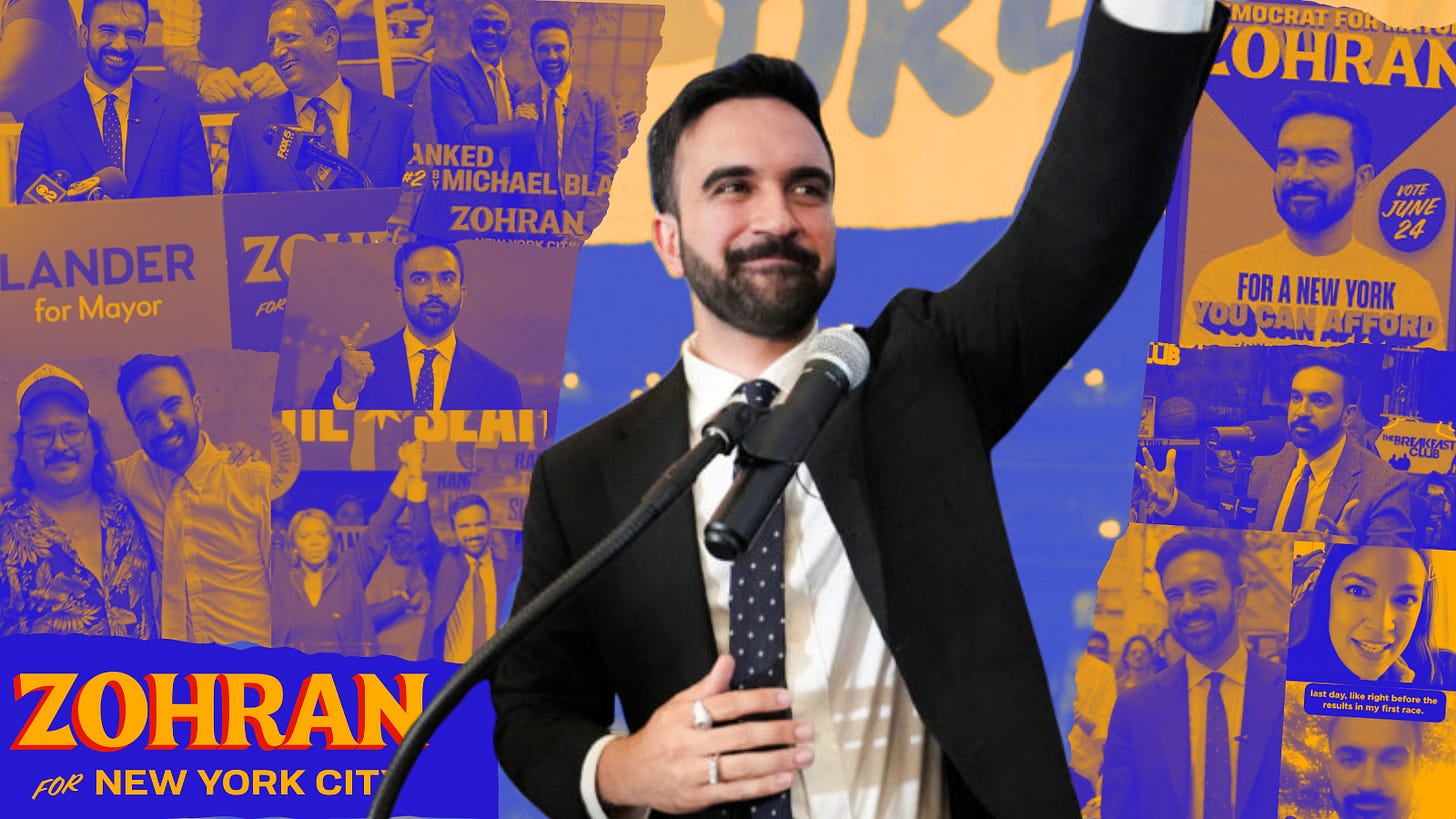The Case for Zohran Mamdani
How Zohran Mamdani showed Democrats what winning looks like and no, it’s not just about socialism.
There’s a broad cross-section of DSA-aligned Zohran supporters and centrist Democrats and Republicans who want the takeaway from last night’s election to be: “Socialism is taking over NYC.” It serves their narratives—but it’s not the full story.
If that were truly the case, we’d have more AOCs in Congress, and folks like Ritchie Torres or Tom Suozzi wouldn’t be representing parts of New York City. The reality is more nuanced.
What we saw was an incredibly charismatic, progressive candidate—Zohran Mamdani—running on widely popular, resonant issues. He communicated through the platforms and voices that voters actually engage with and trust.
Modern Media Mastery
Mamdani’s campaign and its allies invested heavily in Connected TV and streaming ads—essential in a crowded race within a hyper-competitive media market like New York City. But it wasn’t just about paid reach. His short-form Instagram videos crushed.
Short-form content is where attention lives now—especially among Millennials and Gen Z, but increasingly across age groups. Bite-sized, persuasive videos are today’s most effective voter engagement tools. While past campaigns prioritized Twitter dominance, Mamdani’s strategy evolved with the media landscape. His videos, media appearances, and cross-platform collaborations delivered substance with personality.
He showed up on The Breakfast Club to reach a predominantly Black audience. He went on The Late Show with Stephen Colbert to speak to older liberal Democrats. And—and I’ve been saying this for a while—getting in front of young men via social media figures like Stavros Halkias is an untapped goldmine for progressive outreach. Mamdani understood that.
But It Wasn’t Just the Media
Zohran didn’t rely on influencer clout or digital virality alone.
He built coalitions. He earned second-choice votes. And that’s the true promise of ranked-choice voting (RCV): it rewards candidates who unify rather than divide. Mamdani impressed other candidates’ supporters, gained their trust, and gave voters permission to support him without feeling like they were betraying their top pick.
That’s why we saw Cuomo supporters happily taking selfies with Zohran. That’s how you build a winning, multiracial, multigenerational, multi-ideological coalition.
His cross-endorsement with Brad Lander was masterful—especially facing down a Cuomo comeback backed by institutional heavyweights like Rep. Jim Clyburn and President Bill Clinton, along with $20 million in outside spending.
His message to voters was simple: “If I’m not your number one choice, make me your number two.” In a ranked race, that’s a winning formula—one that centers unity before the primary is over, not after.
He Went Outside
Mamdani didn’t just campaign online or behind podiums. He physically walked the length of Manhattan, meeting voters face-to-face. Even in an era where many electeds play it safe, he was out there, showing up with humility and accessibility. That’s how you make people feel seen.
And most importantly—he gave people something to vote for.
To immigrants and Muslim voters, he was someone who looked like them, cared about their communities, and spoke with purpose and authenticity.
To younger voters, he was someone their age talking about housing, affordability, and the real issues they face. He was unapologetic about inequality and unafraid to speak truth on hard issues—whether about Palestine or economic justice. And he wasn’t intimidated by the old guard. That viral moment correcting Andrew Cuomo on the pronunciation of his name? That was a rallying cry.
It wasn’t just popular—it was effective. Especially with a key demographic Democrats are struggling with in 2025: men. Mamdani’s campaign proved that if you give young men something real to vote for, they’ll show up—and vote left.
What Works Beyond NYC
Let’s be clear: Mamdani’s campaign won’t translate wholesale to every district in America—but his strategy absolutely can.
Messaging about opportunity, housing, and economic security works everywhere. Saying “I want to make this city affordable for everyone” is both popular and powerful.
No, Zohran Mamdani might not win a rural House race in Kentucky. But a candidate from Kentucky—running a similarly bold, community-rooted, digital-forward, coalition-building campaign—can. That’s what Democrats need to understand.
A Message to the Old Guard
Last night was a siren: Stop clinging to outdated media tactics, focus-grouped talking points, fear-driven messaging, and the fear of doing what is morally right. The Clinton-era playbook doesn’t work anymore.
Nationally, we’re in a messaging rut. The only way out is to study the tactics and messaging of campaigns like Mamdani’s—campaigns that meet the moment and the people.
If Democrats want to be the party of the people again, we need to act like it—and sound like it.
This is how we win.
TL;DR:
Zohran Mamdani didn’t win just because of ideology—he won because he met people where they were, built real coalitions, embraced modern media, and gave voters something to believe in.
His campaign proves that Democrats can reach new voters—especially young men—by ditching outdated tactics, showing up consistently, and speaking boldly about the issues that actually matter.
If we want to rebuild a working-class, youth-powered Democratic coalition, we need fewer consultants and more campaigns like Zohran’s.






the number of instagram influencers that my friends and I followed who suddenly had reels/posts with Zohran was incredible. praying that the Saints help him in November.
BING BONG